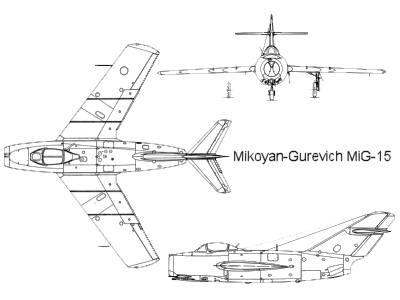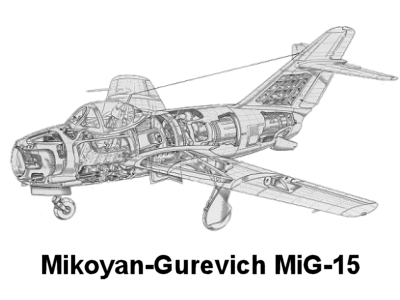Mikoyan-I-Gurevich design bureau is a Russian military aircraft design bureau primarily for fighter aircraft. It was formerly a Soviet design bureau founded by Artem Mikoyan and Mikhail Gurevich, known as 'MiG'. The MiG-15 was one of the first successful swept-wing jet fighters, and it achieved fame in the skies over Korea, where early in the war, it outclassed all straight-winged enemy fighters in most applications. The MiG-15 is believed to have been one of the most widely produced jet aircraft ever made, with over 12,000 built. Licensed foreign production perhaps raised the total to over 18,000. The MiG-15 is often mentioned along with the North American F-86 'Sabre' as among the best fighter aircraft of the Korean War and in comparisons with fighters of other eras.The NATO reporting name was 'Fagot'.
Development
The Soviets did inherit the technology of the very advanced axial compressor Junkers 012 and BMW 018 from Luftwaffe aircraft and plants that they captured at the end of the war. Jets that, in the class of the later Rolls-Royce Avon were some years ahead of the currently available British Rolls-Royce Nene engine. Like all Allied countries, German jet engine technology was sought after and various engines and even whole jets were sent back to their respective countries for flight tests and evaluations, with the technology to help improve their own jet programs. At the end of World War II, the Soviets seized most of the assets of Germany's aircraft industry. The MiG team studied many of these plans, prototypes and documents, particularly swept-wing research and designs and the Soviets did capture plans and prototypes for the Ta-183. The swept wing later proved to have a decisive performance advantage over straight-winged jet fighters when it was introduced into combat over Korea. Representatives from the Soviet Union were also sent to Britain to acquire jet engine technology and to Stalin's amazement, the British Labour government and its Minister of Trade, Sir Stafford Cripps, were perfectly willing to provide technical information and a license to manufacture the Rolls-Royce Nene. Sample engines were purchased and delivered with blueprints. To take advantage of the new engine, the Council of Ministers ordered the Mikoyan OKB to build two prototypes for an advanced high-altitude daytime interceptor to defend against bombers. It was to have a top speed of 1,000 kilometres per hour (620 mph) and a range of 1,200 kilometres (750 mi). The resulting prototypes were designated as 'I-310'. The I-310 was a swept-wing fighter with 35-degree sweep in wings and tail, with two wing fences fitted to each wing to improve airflow over the wing. The design used a single Rolls-Royce Nene fed by a split-forward air intake. A duct carried intake air around the cockpit area and back together ahead of the engine. Its first flight was 30 December 1947 and demonstrated exceptional performance, reaching 1,042 kilometres per hour (647 mph) at 3,000 metres (9,800 ft). The Soviet Union's first swept-wing jet fighter was actually the underpowered Lavochkin 'La-160' which was otherwise more similar to the MiG-9. The Lavochkin La-168, which reached production as the Lavochkin La-15, used the same engine as the MiG but used a shoulder mounted wing and t-tail, it was the main competitive design. Early production examples had a tendency to roll to the left or to the right due to manufacturing variances, so aerodynamic trimmers called 'nozhi' (knives) were fitted to correct the problem, the knives being adjusted by ground crews until the aircraft flew correctly. Eventually, the MiG design was favored for mass production. Designated 'MiG-15', the first production example flew on 31 December 1948. It entered Soviet Air Force service in 1949. The MiG was armed with one 37 mm and two 23 mm cannons.
Back to Top
Operation Deployment
The MiG-15 was widely exported, with the People's Republic of China receiving MiG-15bis models in 1950. Chinese MiG-15s took part in the first jet-versus-jet dogfights during the Korean War. In the Soviet Union, MiG-15 pilots were recruited, with volunteers who had to be younger than 27 years old and priority was given to the WW2 veterans. They formed the 29th GvIAP, which formed the core of the Soviet unit, the 64th Fighter Aviation Corps (64th IAK) to fight as 'instructors'. The swept-wing MiG-15 quickly proved superior to the first-generation, straight-wing jets of western air forces such as the F-80 'Shooting Star', the F-84 'Thunderjet' and the British Gloster Meteor, as well as piston-engined F-51 'Mustangs' and Vought F4U 'Corsairs' with the MiG-15 of First Lieutenant Semyon Fyodorovich Khominich scoring the first jet-vs-jet victory in history when he shot down an F-80C on November 1, 1950. The USSR never acknowledged that its pilots ever flew over Korea during the Cold War. Americans who intercepted radio traffic during combat confirmed hearing Russian-speaking voices, but only the Communist Chinese and North Korean combatants took responsibility for the flying. The Americans recognized the techniques of their opponents whom they called 'honchos', and dubbed 'MiG Alley' the site of numerous dogfights in the northwestern portion of North Korea where the Yalu River empties into the Yellow Sea.
Back to Top
The MiG-15s always operated in pairs, with an attacking leader covered by a wingman. Most of the first regimental, squadron commanders and pilots in 1951 were World War II combat veterans, and were well prepared and trained. But from February 1952, when the crack pilots of the 303rd and 324th IAD were largely replaced by rookies, inexperienced and ill prepared, F-86 Sabres and their well-trained US pilots would keep the edge until the end of the war. The only other advantage the Sabre pilots had was Chodo Island radar station, which provided radar coverage of MiG Alley. Large formations of MiGs would lie in wait on the Chinese side of the border. When UN aircraft entered MiG Alley, these MiGs would swoop down from high altitude to attack. If the MiGs ran into trouble, they would try to escape back over the border into China. Soviet MiG-15 squadrons operated in big groups, but the basic formation was a 6-plane group, divided into 3 pairs, each composed of a leader and a wingman. However, the main mission of the MiG-15 was not to dogfight the F-86, but to counter the USAF Boeing B-29 'Superfortress' bombers. This mission was assigned to the elite of the Soviet Air Force (VVS). To counteract the Mig-15's, three squadrons of the most capable USAF fighter, the F-86 Sabre, arrived in December 1950. Although the MiG's higher service ceiling of 50,000 feet (15,000 m) vs. 42,000 feet (13,000 m) could be advantageous at the start of a dogfight, in level flight, both swept-wing designs attained comparable maximum speeds of around 660 mph (1,100 km/h). The MiG15 climbed faster, but the Sabre turned and dived better. The MiG15 was armed with one 37 mm and two 23 mm cannons, while the Sabre carried six .50 caliber (12.7 mm) machine guns aimed with radar-ranged gunsights.
Back to Top
Claims and Counter Claims
A total of 44 MiG-15s claimed victories in a mission on 12 April 1951, when they intercepted a large formation of 48 B-29 Superfortresses, 18 F-86 Sabres, 54 F-84 Thunderjets and 24 F-80 Shooting Stars heading towards the bridge linking North Korea and Red China over the Yalu river in Uiju. When the ensuing battle was finished, the experienced Soviet fliers had shot down or damaged beyond repair 10 B-29As, one F-86A and three F-80Cs for the loss of only one MiG15. U.S. strategic bombers returned the week of 22-27 October to neutralize the North Korean aerodromes of Namsi, Taechon and Saamchan, taking further losses to the MiG-15. On 23 October 1951, 56 MiG-15bis intercepted 9 Superfortresses escorted by 34 F-86s and 55 F-84Es. In spite of their numerical inferiority, the Soviet airmen shot down or damaged beyond repair eight B-29As and two F-84Es, losing only one MiG15 in return and leading Americans to call that day 'Black Tuesday'. From November 1951 to January 1952 both sides tried to achieve air superiority over the Yalu, or at least tried to deny it to the enemy, and in consequence the intensity of the aerial combats reached peaks not seen before between MiG-15 and F-86 pilots. During the period from November 1950 to January 1952, no less than 40 Soviet MiG-15 pilots were credited as aces, with five or more victories.
The figures given by the Soviet sources indicate that the MiG-15s of the 64th IAK (the fighter corps which included all the divisions that rotated through the conflict) performed 60,450 daylight combat sorties and 2,779 night ones, engaged the enemy in 1,683 daylight aerial battles and 107 at night, claiming to have shot down 1,097 UN aircraft over Korea, including 647 F-86s, 185 F-84s, 118 F-80s, 28 F-51s, 11 F-94s, 65 B-29s, 26 Gloster Meteors and 17 aircraft of different types. The Soviet VVS and PVO were the primary users of the MiG-15 during the war, but not the only ones as it was also used by the People's Air Forces of China and North Korea (known as the 'United Air Army'). From September 1952 until the end of the war, the United Air Army claimed to have shot down 211 F-86s, 72 F-84s and F-80s, and 47 other aircraft of various types though in the process losing 116 Chinese airmen and 231 aircraft: 224 MiG-15s, three La-11s and four Tupolev Tu-2s.
The USAF disputes Soviet and Chinese claims of 650 and 211 downed F-86s, respectively. However, one unconfirmed source claims that the US Air Force has more recently cited 230 losses out of 674 F-86s deployed to Korea. The differing tactical roles of the F-86 and MiG-15 may have contributed to the disparity in losses: MiG-15s primarily targeted B-29 bombers and ground-attack fighter-bombers, while F-86s targeted the MiGs. In aerial combat, F-84 Thunderjet pilots were credited with eight MiG-15 kills against a Soviet-claimed loss of 64 aircraft.
Back to Top
Post Korea
In the early 1950s, the Soviet Union delivered hundreds of MiG-15s to China, where they received the designation J-2. The Soviets also sent almost a thousand MiG-15 engineers and specialists to China, where they assisted China's Shenyang Aircraft Factory in building the MiG-15UTI trainer (designated JJ-2). China never produced a single-seat fighter version, only the two-seat JJ-2. The USSR built around 12,000 MiG-15s in all variants. It was also built under license in Czechoslovakia (as the S-102 and S-103) and Poland (as the Lim-1 and Lim-2, and two-seat SB Lim-1 and SB Lim-2).
Back to Top
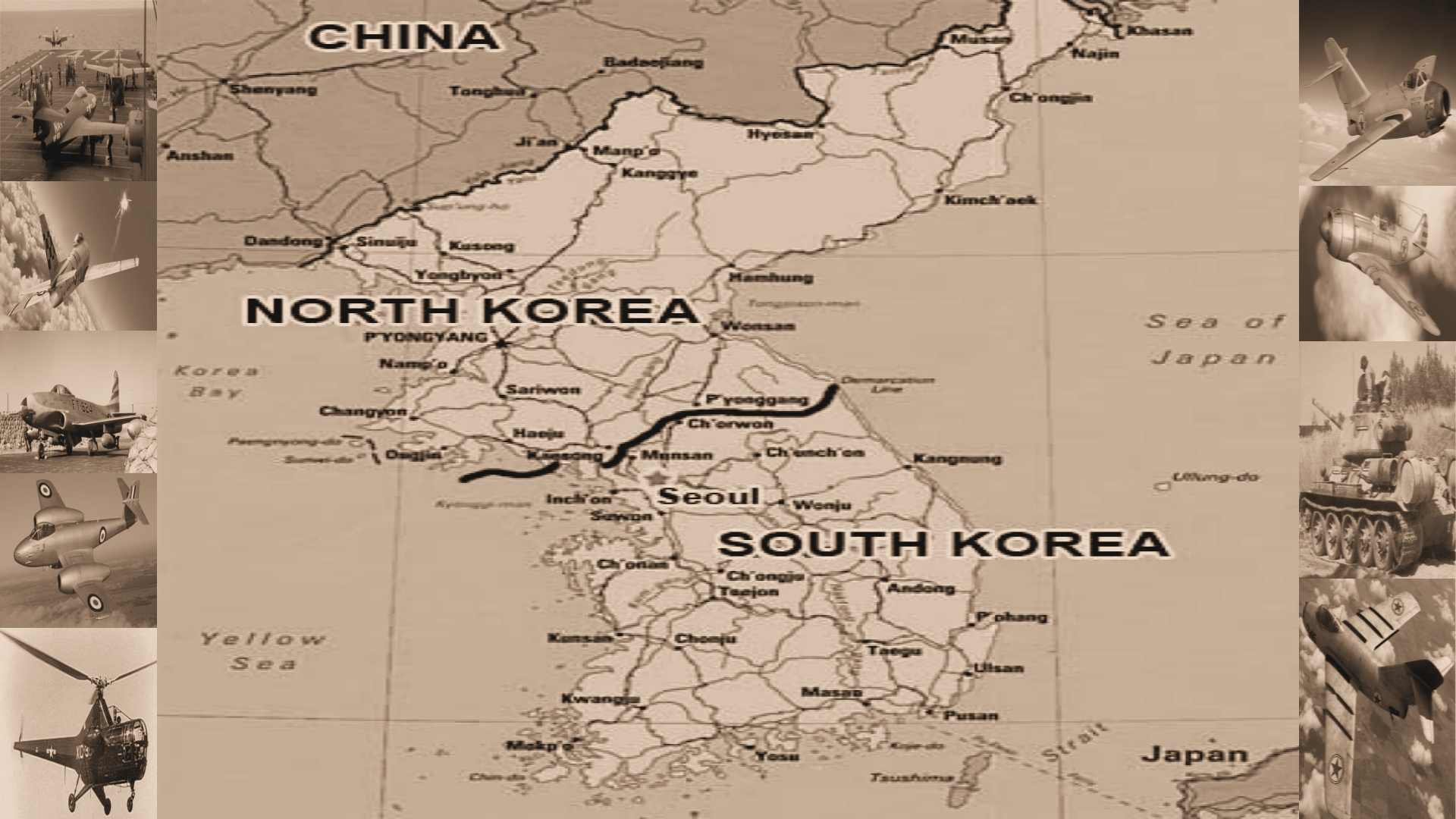

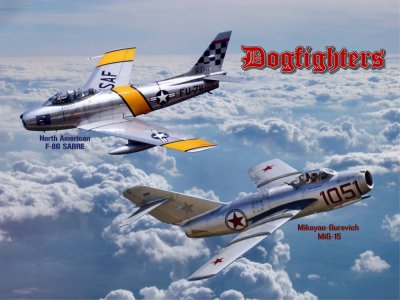
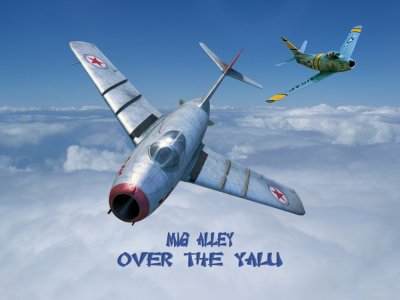

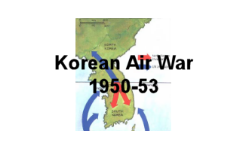 Korean War
Korean War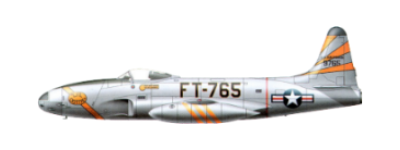 P-80 Shooting Star
P-80 Shooting Star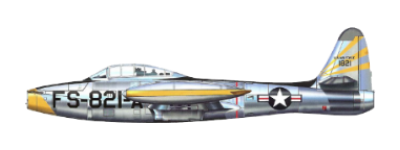 F-84 Thunderjet
F-84 Thunderjet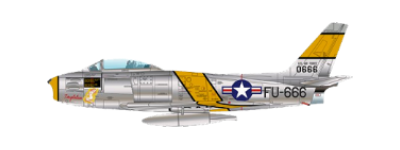 F-86 Sabre
F-86 Sabre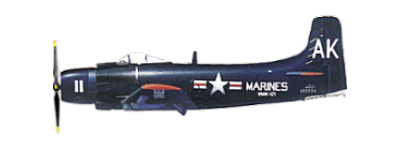 AD1 Skyraider
AD1 Skyraider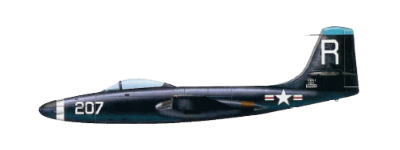 F2H Banshee
F2H Banshee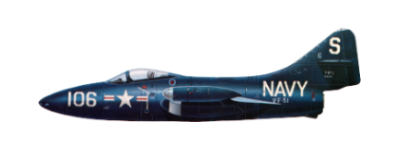 F9F Panther
F9F Panther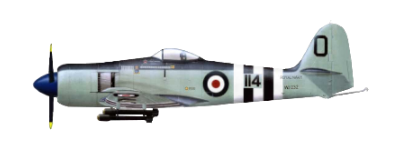 Seafury
Seafury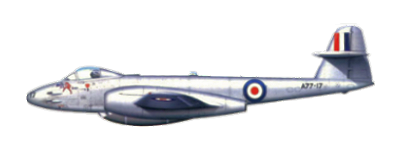 Meteor
Meteor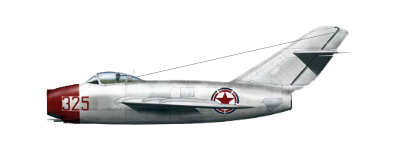 Mig-15
Mig-15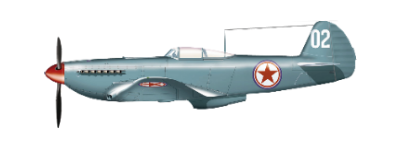 Yak-9
Yak-9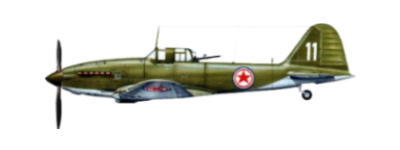 IL-10 Shturmovik
IL-10 Shturmovik
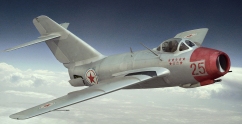

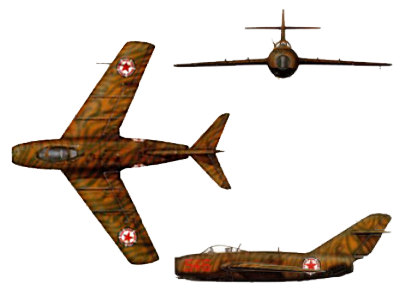
 Mikoyan-Gurevich MiG-15
Mikoyan-Gurevich MiG-15